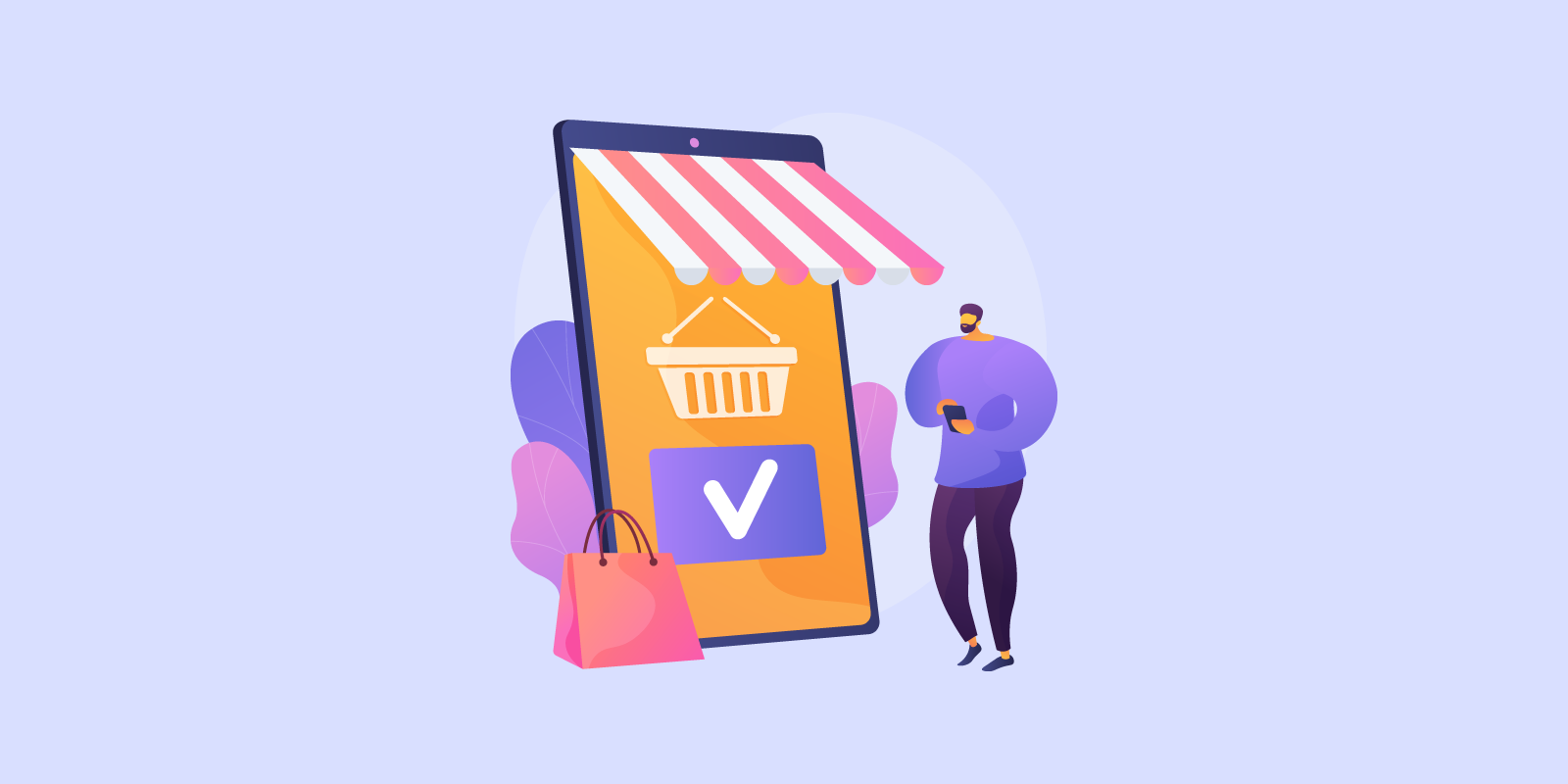Social media marketing is an excellent channel to promote your brand. But…
Let’s be real: growing followers is overrated.
You get tons of people following you, liking your posts, commenting, sharing… But yet, the revenue from social media isn’t coming — why?
Simple, you’ve failed to turn followers into customers.
All the social impressions and reactions you get mean nothing if they don’t lead your ideal prospects to make a purchase — that’s why they’re famously called “vanity metrics.”
However, it doesn’t have to be like this if you build a sales funnel that converts your social media followers into customers.
Keep reading to find out how.
- What is a conversion funnel?
- How to create a follower-to-customer conversion funnel
- 6 conversion strategies for Instagram
- 6 conversion strategies for Facebook
In this article
What is a conversion funnel?
A conversion funnel is a process where a prospect — who doesn’t know your brand — converts into a new customer by going through a series of steps and phases.
On social media, this would involve leveraging the platform to expose your brand and drive potential customers to your website.
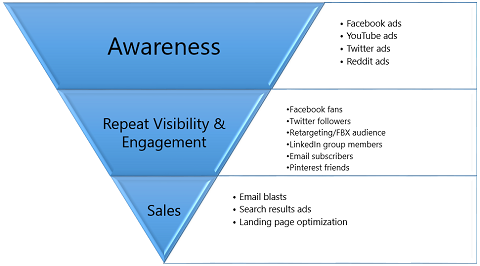
Your prospects enter at the top as total strangers and leave at the bottom as new customers. The funnel shape represents, inevitably, that only a percentage of the input will come out as output.
The steps of a conversion funnel represent the stage of awareness of your prospect. Each is associated with a channel and action—a channel to communicate with your prospect and the action they must take to advance.
In your funnel, the conversion rate between each step is key because it directly affects the ROI of your campaigns. So it’s a common goal to optimize each step for maximum revenue.
How to create a follower-to-customer conversion funnel
There are three main stages in a sales funnel: Top funnel (ToFu), Middle funnel (MoFu), and Bottom funnel (BoFu)
Top funnel
First, you want prospects to become aware of your brand.
With social media, you need to post content, interact with your audience, and encourage shares to expand your reach and attract people looking for the solution you provide.
In short, you need to embrace content marketing if you want to get attention. For this, having the right content resources at hand will save you 50% of the trouble.
Your content must attempt to solve a problem, provide valuable resources, and position your brand as an expert on the topic. It must appeal to what your target customers are looking for.
The goal: taking your audience out of social media.
Whether it is to your website, a form, or another platform, when someone takes the time to visit your website and see what’s going on, there’s interest. They’re no longer just aware of your name; they want to see what’s going on. They reached the next stage.
Middle funnel
At this stage, your prospect is aware that a solution for their problem exists.
You want to dig deeper into the subject by getting them through more exclusive content such as contests, giveaways, webinars, and any kind of special resource that your ideal customer will find extra valuable.
In short: you need to offer a lead magnet.
The goal is to generate leads — people who show interest in your brand and want to stay in touch with you.
And the specific action you want them to make is to subscribe to your email list, so you can send them autoresponders, newsletters, and heavily-targeted campaigns that would eventually lead them to become customers.
Bottom funnel
Here’s where the sale happens.
Your job here is to stay true to the promise of solving your prospect’s problems and to provide them with value regularly until you’ve built a solid relationship with them.
You accomplish this with email sequences, autoresponders, nurturing campaigns, and everything you can do with email marketing. And only then can you start selling your main products as the best decision to reach your customer’s goals.
The action is simple: to click on your email’s link and make a purchase.
Now, once they’ve become new customers, don’t stop! You need to keep the conversation going and make upsells, implement referral programs and loyalty programs! Keep your customer relationsihp alive.
6 conversion strategies for Instagram
Instagram strategy #1. Post Instagram-exclusive content
Instagrammers love to feel special. Therefore, posting engaging content exclusive for your Instagram followers is a great way to both grow your follower numbers and increase their engagement.
There are many ways of doing this:
- Reveal a new product or an event to your Instagram audience, sharing some sort of “secret” that no one else knows.
- Use Instagram’s unique features to go live and show content that you wouldn’t see on other platforms such as news, hosting events, showing off how to use your products and Q&A’s.
The goal here is to generate some sort of hype in your audience and encourage them to take a look at your website for more offers (discount codes, free trials, etc.) — generating more leads in the process.
Instagram strategy #2. Share behind-the-scene content
According to SproutSocial, transparent brands are more likely to get a purchase from 53% of customers.
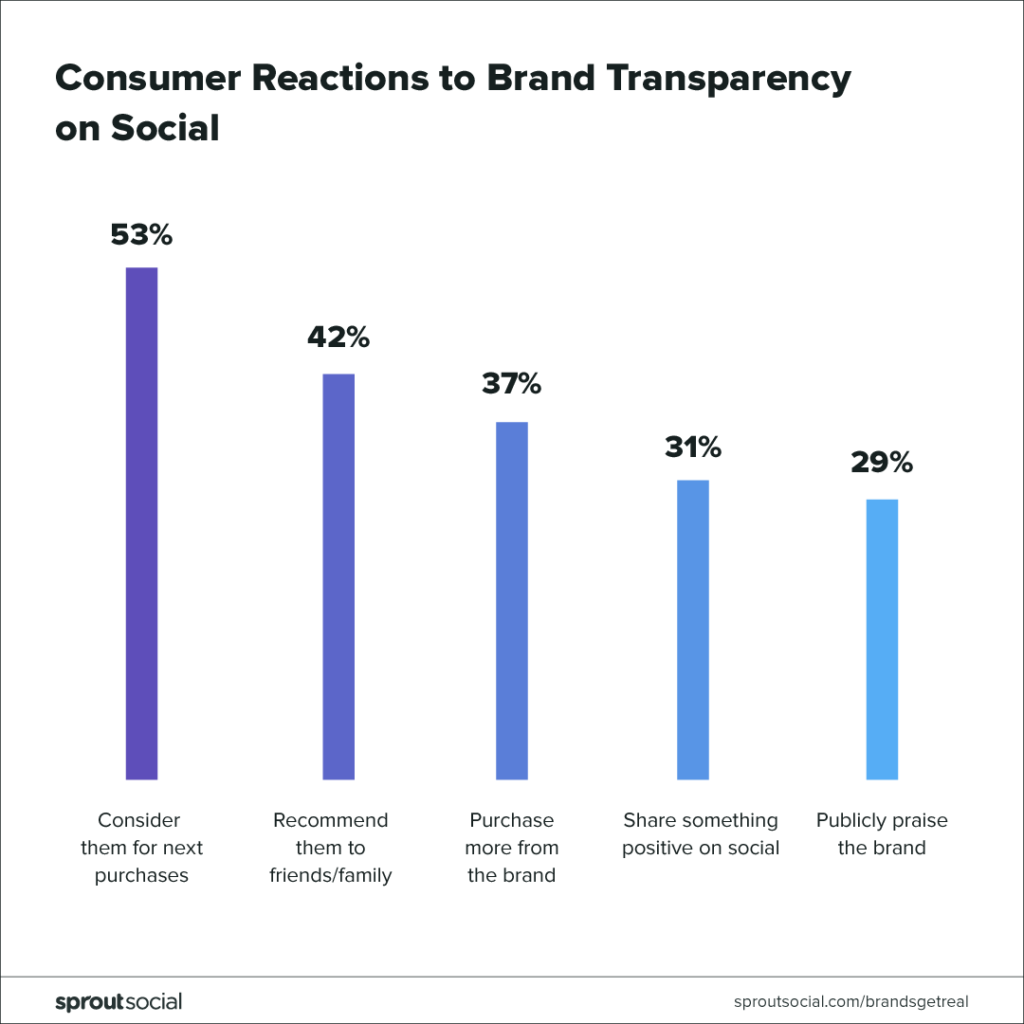
You see, trust is the oil for your sales machine — and the bigger the purchase, the more oil you need.
Instagram, as a visual platform, is an excellent place to be transparent. As you can show how your team works, the process behind your products, or funny stories that happened in the office.
Sharing behind-the-scenes content like this is a no-brainer as the platform makes it easy to engage and show things that wouldn’t be explained otherwise. Here are some ideas for it:
- Share a picture of your customers getting a product.
- Post photos or videos of any event or conference you’re running.
- Show a video of your team brainstorming for ideas and ask your audience to contribute.
- Make a video of your CEO speaking, talking about your brand, or just sharing stories for your audience.
Instagram strategy #3. Leverage user-generated content (UGC)
According to a TINT report, 93% of marketers believe that content generated by people creates more trust than content created by brands.
This goes back to the fact that social proof is essential for sales. And incidentally, UGC helps you get both content and social proof — hitting two birds with one stone.
On Instagram, sharing how your customers use your products, how they’ve solved a problem, or how they simply enjoy themselves with it is excellent to build the trust you need for your sales.
But where do you get user-generated content from? Here are some tactics:
- Host a photo contest. Ask your followers to post a picture of them featuring your product, and let them know that you’ll share their photos on your Instagram even if they don’t win.
- Search your brand’s name. Some customers might have shared a potential UGC without tagging you, so try to search for relevant keywords that could show you those posts.
- Encourage customers to share a photo featuring your product (and using a specific hashtag). You can ask for it by email after they’ve made a purchase, on your website, etc. Don’t limit yourself to Instagram for finding juicy UGC.
Instagram strategy #4. Host Instagram contests and giveaways
Running contests or giveaways on Instagram is the most straightforward way to generate more leads.
Contests allow your brand to get more immediate attention, attract people who don’t know your brand, and encourage them to give you their email address (or even buy a product right away) — they impact every stage of your social media funnel.
Here’s the process to host a contest:
- Start with a seasonal theme. Whether it is your brand’s anniversary, Mother’s day, 100,000 followers celebration, or anything relevant to your business, use it as a theme for your contest.
- Come up with a good prize. The prize can be something as simple as a gift card to something more elaborate like a special bundle or free 6-month premium subscription. What’s critical about the price is that it’s good enough to incentivize people to give you their email address for it.
- Distribute through all your marketing channels. Use a contest tool, set a time to participate, encourage your audience to share your post with their friends, and keep generating buzz until the winner announcement date.
Remember, on Instagram, you can only put one link in the bio, so always send your audience to click the link on your bio to participate. Just like here:
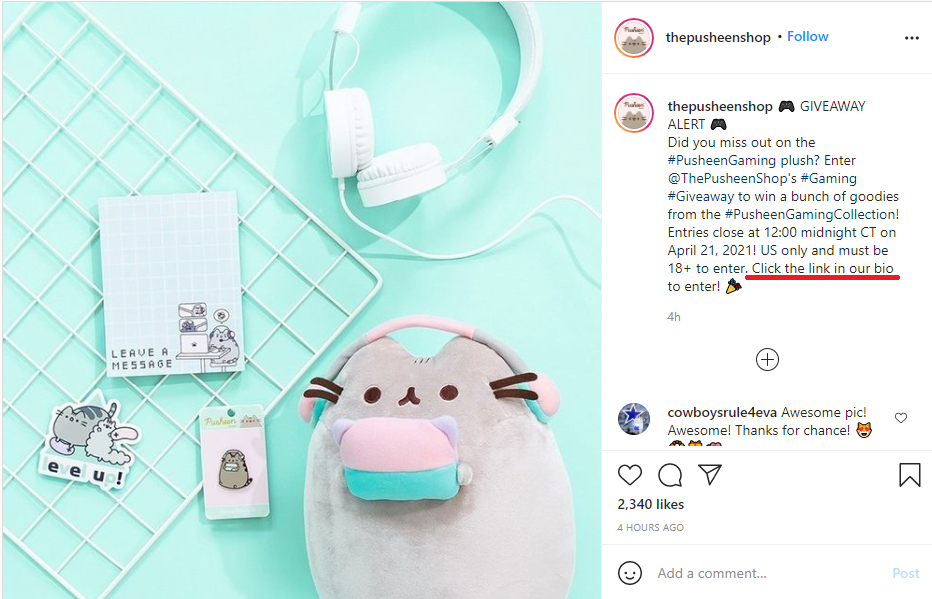
Instagram strategy #5. Use Instagram analytics
You can use Instagram’s analytics tool to focus on content that’s sending traffic to your website and ditch out what doesn’t work. So, when taking a look at your Instagram analytics, make decisions based on the following:
- Your audience data. Their gender, age, demographics, what they like, what they don’t like. Build a persona based on the information you get, and create content that resonates with it.
- Your content performance. Check out what’s driving more impressions and comments and what doesn’t. What’s the difference between them? Use this data to create a guideline for creating content that appeals to your audience.
- Audience activity. What are the days of the week and the hours of the day where your followers are more active? Use this to create a social content schedule and ensure that your followers have a chance to see your posts.
Instagram strategy #6. Partner with influencers
Instagram is the best platform to invest in influencer marketing according to 89% of marketers.
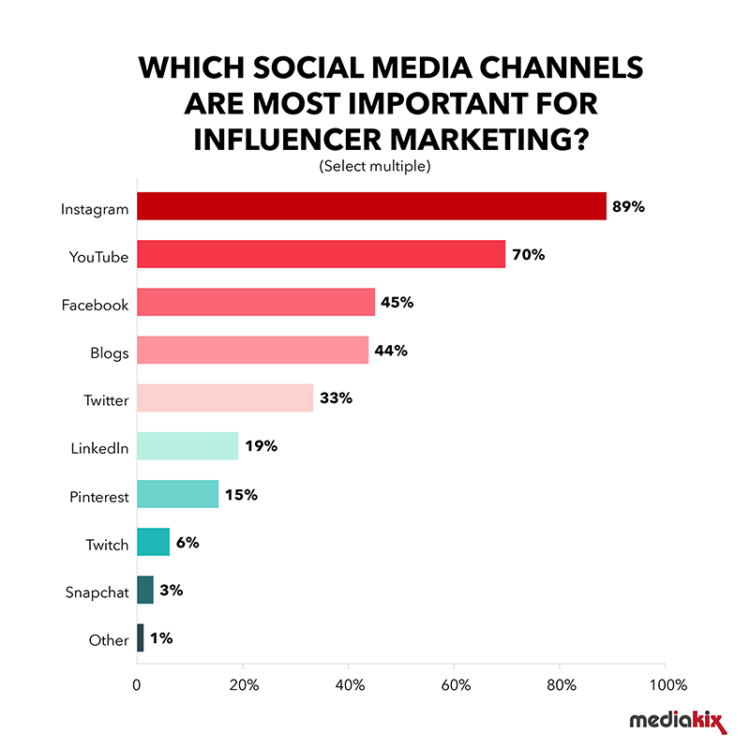
And for a reason, according to a Twitter study, 49% of online buyers trust influencers when they recommend products.
Influencer marketing is the ultimate way to expand your brand awareness and drive traffic to your website using Instagram.
There are multiple ways to collaborate with influencers, including:
- Paying them for sponsorship and offering a discount code
- Giving them an affiliate link
- Partnering to create a special piece of content together
- Hosting an event or contest that benefits both audiences
Websites for finding influencers in your niche are many. Learn how to find the best influencers for you, and once you’ve collected enough influencer’s accounts, reach out to them and ask them if they would be interested in collaborating with you.
6 conversion strategies for Facebook
Facebook Strategy #1. Create “Fan-Only” coupons
Coupons incentivize people to not only make a purchase but to explore your store and buy what they like. So instead of buying a predetermined product because it’s heavily discounted or free, they’d take a chance to experience what it feels like to buy from you.
Promoting coupons doesn’t have to be complicated. Just make sure you’re doing the following:
- Keeping the copy short. Including a concise and straightforward call-to-action (like “claim your coupon” or “follow the link”). The simpler you keep the text, the better.
- Posting an outstanding image. Show information about the coupon, include some products, and even better, show a compelling reason to get one of your products.
- Explaining the process. Show how to use the coupon as if you were talking to 5 years-olds. Make it as easy as possible to use the coupon.
Facebook Strategy #2. Use story-telling techniques
Stories are hardwired in our heads.
When we hear stories, oxytocin is released in our brain and makes us a lot more likely to increase our trust with the person telling the story — and you know that trust is essential to oil your sales machine.
But how can you start using storytelling on Facebook?
- Tell a story from your customer’s perspective. Focus on their goals, the problems they face, and how your product is not the end but only the means to success.
- Tell stories with photos. Images can say more than words, and since Facebook isn’t too friendly with walls of text. You can leverage images showing a transition from failure to success, revealing your brand’s origins, or even using user-generated content to tell your customers’ real stories.
- Refer to a celebrity or any well-known name in your niche. Take benefit from authorities in your niche (like influencers), and tell a story that involves them and your brand.
- Show less-known ways to use your products. If you feel like your customers don’t know how to use your products, show them how. You can take this as an opportunity to tell a personal story and position your brand as an authority.
Facebook Strategy #3. Create transparent and personal content about your business
Fans love to get personal. They’ll love to know more about the people behind your brand, the story of your product, and the lessons you’ve learned in the process.
A common practice is to take the founder as the public face of the company. And get him invited to podcasts, create video content, and let him communicate directly with the audience.
Slidebean’s CEO, Caya, took this role by uploading regular videos on the company’s Youtube channel, videos that target startups that want to raise capital—showing his face, personality, and personal brand.
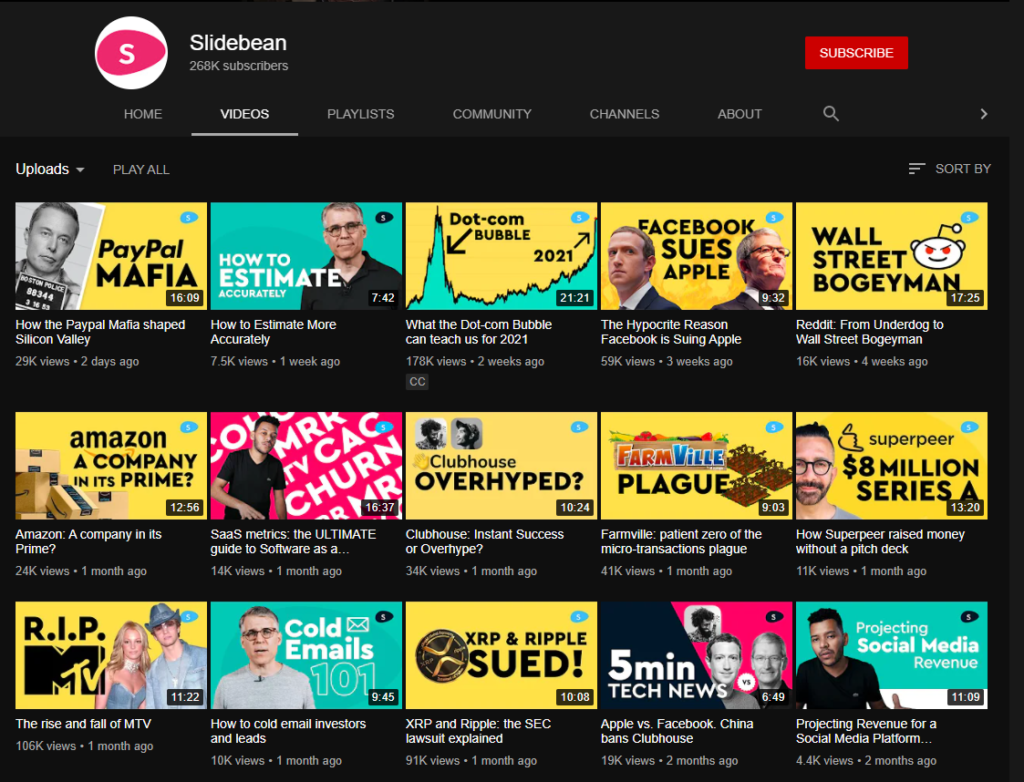
On Facebook, you could promote a podcast where your company’s face got invited, or post a fraction of a new youtube video. Whatever it is, the point is to get intimate with how you and your company operates.
Facebook Strategy #4. Share detailed customer testimonials
People don’t care about what you say but about what their friends say.
On Facebook, you can leverage customer’s testimonials to increase trust with your audience. So if you find customer’s sharing their experience with your product, don’t hesitate to share it with your audience — let them tell a story about your brand.
Like collecting UGC with Instagram, you can encourage your audience to tell their experience with your product in the comments. This is great because Facebook allows more extensive comments and posts than Instagram or Twitter — you can even host a contest about it.
Now, it’s essential to know how to identify good testimonials.
Great testimonials are detailed and tell a story. They dig into what the customer needed, the problem they faced, and how your product helped them. Take the following review as an example:
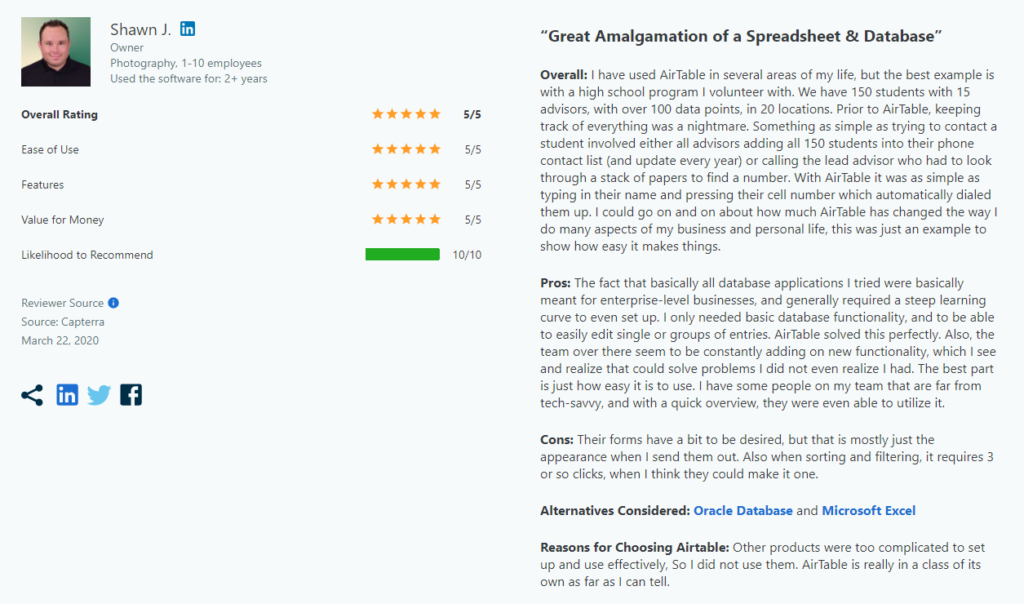
So when you ask for testimonials, ask for a real story involving your product; your customers will do the rest!
Facebook Strategy #5. Use gated content to generate leads
On Facebook, gated content works particularly well for generating leads since people are also looking for valuable information (instead of fancy products, like on Instagram).
Gated content means that it’s locked behind a subscription wall, meaning that you need to exchange your email address for that piece of content.
This is great if you want to start a WordPress blog and use exclusive content as a lead magnet that redirects traffic to your domain (improving your SEO results).
But what should you offer as gated content? Here’s a list of formats that work well:
- Industry reports
- Podcasts
- Case studies
- Content upgrades
- Tutorials
- Cheatsheets
- Checklists
- Swipe files
- Templates
What’s essential here is to offer something so valuable that people will think they’re robbing you. Make sure that you ask your Facebook followers to tell you about their biggest challenges and troubles before creating gated content.
Facebook Strategy #6. Design an engaging social media landing page
If you want your conversion funnel to work, you’ll need to create a landing page that converts.
Whether it is to offer your lead magnet, to get more participants for your contest, or to simply sell a product, a well-crafted landing page is vital for the final step to happen.
To create a landing page that works. There are some best practices you need to be aware of:
- Landing pages should only lead to the desired action. No menus, no internal links, no going to the homepage by clicking the logo. Just the “subscribe” or “buy” action.
- Copy should be written like a sales letter. Highly persuasive, clear, to the point, with concise paragraphs, and using bolds and italics.
- The design should highlight the copy and make it as easy for the visitor to read it.
- Copy should be structured. You can get started by using copywriting formulas such as AIDA or PAS. Then you can optimize your copy from there (or hire a copywriter to do that job for you).
- Include graphics, images, and any visual value to illustrate what the copy is saying.
The moment your prospect performs the action that the landing page is meant to sell, it means that your conversion funnel works. So do your best to optimize it.
Start converting your customers today
If you’ve been using your brand’s social profiles to share random blog posts and talk about your brand two times per quarter, then this post must have served you well.
And if you are already nailing it on social media, this post might have given you some ideas.
In the end, you must approach social media marketing with a plan and a strategy — just like any other channel.
Creating a social media funnel is a strategy; scheduling your content is planning.
Whatever action you take, you need to start focusing on converting today.
So as a next step, create a new document and illustrate your current funnel. See what you’re missing and work on it — you won’t regret it!
